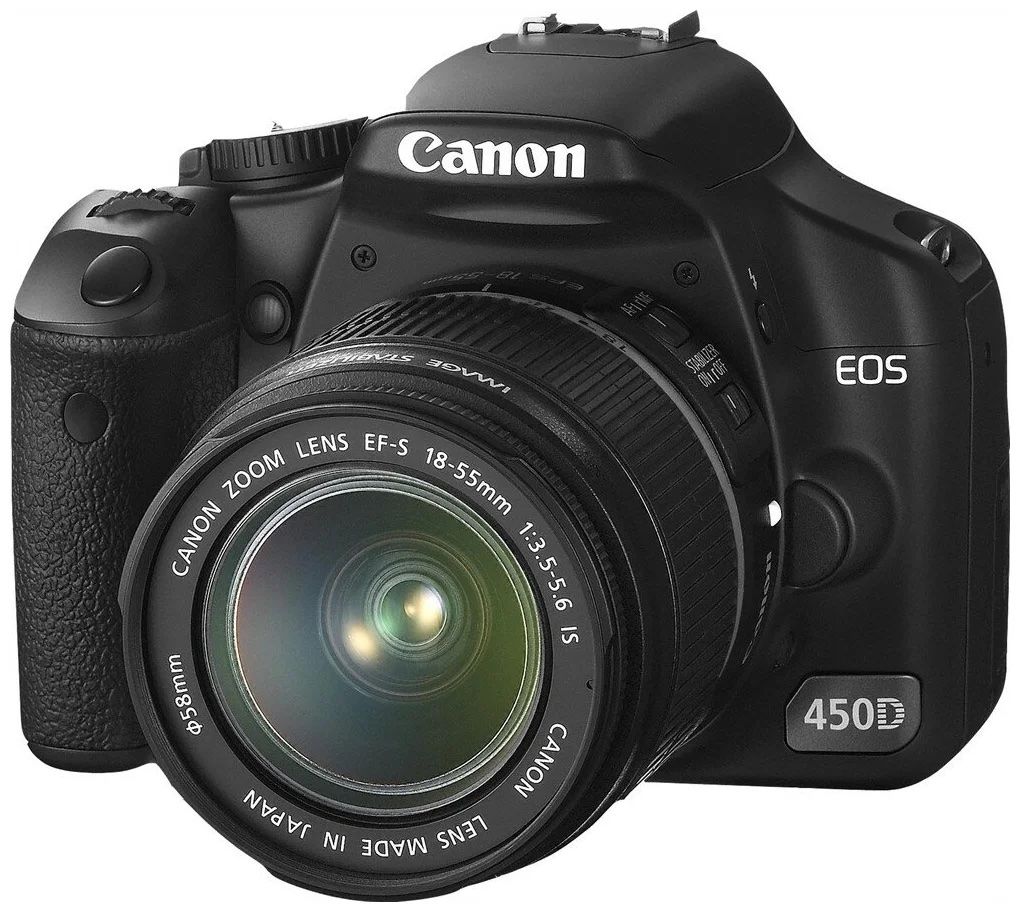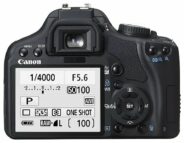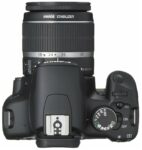Canon EOS 450D
aka Canon EOS Kiss X2
aka Canon EOS Rebel XSi
APS-C AF digital SLR camera
Specification
| Production details: | |
| Announced: | January 2008 |
| System: | ● Canon EOS APS-C (2003) |
| Format: | |
| Maximum format: | APS-C |
| Imaging sensor: | 22.2 × 14.8mm CMOS sensor |
| Resolution: | 4272 × 2848 - 12 MP |
| Crop factor: | 1.62x |
| Sensor-shift image stabilization: | - |
| Mount and Flange focal distance: | Canon EF-S [44mm] |
| Shutter: | |
| Type: | Focal-plane |
| Model: | Electronically controlled |
| Speeds: | 30 - 1/4000 + B |
| Exposure: | |
| Exposure metering: | Through-the-lens (TTL), open-aperture |
| Exposure modes: | Programmed Auto |
| Aperture-priority Auto | |
| Shutter-priority Auto | |
| Manual | |
| Physical characteristics: | |
| Weight: | 475g |
| Dimensions: | 128.8x97.5x61.9mm |
Manufacturer description
Amstelveen, The Netherlands, 24 January 2008: Canon today launches its latest D-SLR, the EOS 450D. Featuring a 12.2 Megapixel CMOS sensor, EOS Integrated Cleaning System, 3.0” LCD with Live View mode and a new 9-point AF system, the model presents consumers with an unprecedented level of image quality and versatility at this end of the market.
The EOS 450D employs features already proven in Canon’s professional EOS-1 series cameras, including the DIGIC III image processor and a redesigned menu system that enables features such as direct control of Speedlite flash units from the camera LCD. A choice of 13 custom functions allows the photographer to customise the camera to their shooting style.
“The EOS 450D bears the fruits of more than 20 years of ongoing investment into EOS,” said Mogens Jensen, Head of Canon Consumer Imaging, Europe. “This camera continues Canon’s policy of taking technologies proven in the professional arena and putting them within reach of a wider market of amateur photographers.”
The EOS 450D features:
- 12.2 Megapixel CMOS sensor
- Canon’s EOS Integrated Cleaning System
- 3.5 frames per second
- 3.0” LCD with Live View shooting
- 9-point wide-area AF system with f/2.8 cross-type centre point
- Picture Style image processing parameters
- DIGIC III image processor
- Digital Photo Professional RAW processing software1
- Compact and Lightweight body
- Fully compatible with all Canon EF and EF-S lenses and EX-series Speedlites
The EOS quality advantage
With all key components developed and manufactured in-house, EOS offers photographers a unique quality advantage. The EOS 450D’s specially designed 12.2 Megapixel sensor employs Canon’s high-sensitivity, low-noise CMOS technology to produce richly detailed images with minimal grain. The DIGIC III processor ensures superior image rendering and rapid response times, with an almost instant 0.1 start up. Image data is processed at 14 bits for Delivering a burst rate of 3.5 frames per second, the DIGIC III processor works with the image buffer to handle up to 53 JPEGs (6 in RAW) without interruption.
Built for better photos
The EOS 450D is designed to make photography a fluid experience for photographers of all levels and experience. Housed in a compact body that weighs less than 475 grams, the camera features an improved grip design that provides a natural, ergonomic fit with the user’s hands. A large, bright viewfinder makes image composition clearer and more comfortable. The menu system inherited from professional EOS cameras uses a simplified tab structure that does away with scrolling. It includes a user-defined My Menu tab for instant access to frequently used settings.
Several custom functions are available to optimise the quality of photos captured in a range of situations. Highlight Tone Priority boosts the dynamic range at the highlight end, providing better tonal detail from wedding dresses, cloudy skies and other bright objects. The new Auto Lighting Optimiser corrects brightness and contrast during image processing, while improving skin tones in portraits by ensuring correct exposure for faces. Photographers can also enable additional noise reduction for shots captured at high ISO speeds.
Live View
Available for the first time on a Canon consumer D-SLR, Live View mode makes it easier to shoot from awkward angles, such as ground-level macro shots or when shooting from a tripod. The image from the Live View mode is displayed as a smooth, 30fps video feed on the 3.0” LCD, which is 50% brighter than the screen of the EOS 400D. A grid line display and live histogram can be selected to help with shot composition and exposure. While focusing, the photographer can zoom in on specific details with up to 10x magnification of the image displayed on the LCD screen. Two types of auto focus are available: Quick AF flips the camera mirror momentarily to engage the AF sensor; Live AF uses the image contrast data to focus - a method familiar to anyone upgrading from a compact digital camera.
For studio environments, remote Live View lets the photographer compose, adjust settings and capture the shot from a PC using the supplied EOS utility software.
Other improvements
The EOS 450D complements its headline features with a host of smaller improvements that enhance the photographic experience. The viewfinder now displays all key exposure information including ISO speed. The addition of spot metering (4% of viewfinder) allows for greater control over exposure in tricky lighting conditions. PictBridge functionality has been expanded so that photographers can correct horizons and add picture effects before printing. A new high capacity battery extends shooting time on a single charge to a maximum of 500 shots.
Software
The EOS 450D is supplied with a comprehensive software suite that provides everything the photograph needs to manage and process images. This includes Digital Photo Professional (DPP), a powerful RAW converter that provides complete RAW image processing control. DPP also integrates with camera features such as Dust Delete Data and Picture Styles. The supplied Picture Style Editor software can be used to create custom Picture Styles for fine control over colour display. The camera also comes with EOS Utility, Image/Zoom Browser and Photostitch.
Table of contents
Clickable
Instruction manual
Clickable
Canon EOS APS-C system cameras
Clickable
- Canon EOS 1000D
- Canon EOS 100D
- Canon EOS 1100D
- Canon EOS 1200D
- Canon EOS 1300D
- Canon EOS 2000D
- Canon EOS 200D
- Canon EOS 20D
- Canon EOS 250D
- Canon EOS 300D
- Canon EOS 30D
- Canon EOS 350D
- Canon EOS 4000D
- Canon EOS 400D
- Canon EOS 40D
- Canon EOS 450D
- Canon EOS 500D
- Canon EOS 50D
- Canon EOS 550D
- Canon EOS 600D
- Canon EOS 60D
- Canon EOS 650D
- Canon EOS 700D
- Canon EOS 70D
- Canon EOS 750D
- Canon EOS 760D
- Canon EOS 77D
- Canon EOS 7D
- Canon EOS 7D Mark II
- Canon EOS 800D
- Canon EOS 80D
- Canon EOS 850D
- Canon EOS 90D


